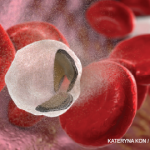Patients with AIHA may rarely have severe complications, such as Evans syndrome, an autoimmune anemia associated with immune thrombocytopenia. Thrombocytopenia may occur before, after or along with hemolytic anemia and may be symptomatic with bleeding, she said. About 30% of people with AIHA test positive for antinuclear antibodies (ANA), even if they don’t have SLE, although many patients may develop lupus later. When AIHA warm autoantibodies are in high titer, they may also fix complement. Usually, this occurs in patients with very severe hemolysis.
Laboratory testing of AIHA patients typically shows elevated reticulocyte, increased lactate dehydrogenase (LDH), decreased haptoglobin and increased bilirubin (direct > indirect), said Dr. Gernsheimer. Because this type of hemolysis tends to be extravascular, it is uncommon to see either hemoglobinemia or hemoglobinuria in these patients unless the hemolysis is very severe.
“One of the most important things we do as hematologists is look at the peripheral blood smear. Here, we do the direct anti-globulin or Coombs test. This is particularly true in lupus patients,” said Dr. Gernsheimer. “Don’t assume if a patient has a history of AIHA that was Coombs positive that the next time you see them hemolyzing, it’s the same thing. It is important to rule out other causes of hemolysis that may be seen in patients with lupus.”
Normally, red blood cells have a great deal of redundant membrane that gives the cell a concave, disc shape. Cells are able to change shape easily and move through small vessels delivering oxygen, she said. When antibodies attach to the red cells, they are recognized by macrophages, which engulf the cell or chew off a portion of it. As a result, the cells lose membrane and their concave shape, are smaller and develop a sphere shape, turning into spherocytes.
Temperature Matters
The Coombs test, or direct antiglobulin test for hemolysis, involves taking the patient’s antibody-coated red blood cells and incubating them with Coombs serum, an anti-human immunoglobulin, said Dr. Gernsheimer. “There will be cross-linking, and these cells will agglutinate. The technician, hopefully, if they are experienced enough, will see these cells fall to the bottom of the test tube. The technician can visually see and measure the agglutination—but it’s not nearly as specific as you might think.”
AIHA patients are mostly warm antibody mediated, but not always. In cold antibody mediated AIHA, complement is fixed. Agglutination will be seen with anti-C3 Coombs sera. If cold antibody-mediated AIHA is suspected, it may be important to perform a thermal amplitude, where the technician checks for antibody binding at higher temperatures—most testing is done at room temperature—to see if the antibody is active at physiologic temperature.


